#microfiber pollution
Explore tagged Tumblr posts
Text
Reducing microfibers from laundry
Microfibers are plastic fibers smaller than 5 millimeters and are one type of microplastics. Microplastic pollution is becoming a large problem in the oceans, lakes and streams, soil, food, air, and critters. While microfibers have many sources, a major source is our laundry. Clothing made from synthetic materials sheds tiny fibers during the wash cycle, and these microfibers end up in the environment because wastewater treatment plants can’t remove them. Microfibers are also released when clothing is dried using a gas or electric dryer. The attached article discusses ways to prevent or reduce microfiber pollution from doing the laundry.
37 notes
·
View notes
Text
Coats Introduces Eco-B: A Sustainable Solution to Microfiber Pollution
India, 4th Apr ’23: Coats, a leading manufacturer of industrial threads, has recently launched Eco-B, a sustainable solution to microfiber pollution. Eco-B is an innovative product that has been developed to reduce the amount of microfiber pollution generated by textile manufacturing.
Microfiber pollution is a major environmental issue that is caused by the release of tiny plastic fibres from clothing and other textiles during washing. These fibres can end up in rivers and oceans, where they can harm marine life and enter the food chain. Microfiber pollution is a serious problem that has gained widespread attention in recent years, and many companies are now working to develop sustainable solutions.
Eco-B is a solution developed by Coats to address this issue. It is a specially engineered thread made from a blend of sustainable materials, including recycled polyester and biodegradable materials. This unique combination of materials helps to reduce the shedding of microfibers during washing, minimising the amount of plastic pollution that is released into the environment.
Eco-B has been designed to be used in various textile applications, including apparel, home furnishings, and automotive textiles. It can be used in both woven and knit fabrics, and it is compatible with a range of production processes. This makes Eco-B a versatile and practical solution that can be easily integrated into existing production lines. Coats has developed three variations of Eco-B, as Epic Eco-B, Gramax Eco-B and Sylko Eco-B offering.
In addition to its sustainability benefits, Eco-B also offers superior performance and quality. It is a high-strength thread that is resistant to abrasion, making it ideal for use in high-wear applications. It also has excellent colour fastness and washability, ensuring that textiles made with Eco-B remain vibrant and durable over time. Check out this amazing thread from here - https://www.coats.com/en/products/threads/epic/epic-eco-b
About the Author:
Coats is the world’s leading industrial thread company. They are headquartered in the UK, with a workforce of 17,000 in 50 countries across six continents around the world. Coats provide complementary and value-adding products, services and software solutions to the Apparel & Footwear industries. Coats apply innovative techniques to develop high technology Performance Materials threads, yarns and fabrics in areas such as Transportation, Telecoms and Energy, and Personal Protection.

0 notes
Text
Everything You Need To Know: The Dangers of Polyester
Polyester has a heavy impact on the environment and our overall health. When you think polyester, you may associate it with other natural fibers, such as cotton or wool. But surprise – polyester isn’t natural at all! On the contrary, there are many dangers of polyester that we need to be aware of. Polyester breaks down into tiny fragments called microfibers. These plastic fragments are everywhere…

View On WordPress
#antimony#dangers of polyester#eating plastic#eco friendly#laundry filters#microfibers#microplastics#plastic clothes#plastic in the body#pollutes oceans#polyester is plastic#sensitive skin#sustainable#toxic chemicals#wanderlustrachel#wanderlustrachelblog
0 notes
Text
Microfibers and the Environment: Understanding the Consequences
Microfibers and the Environment: Understanding the Consequences #MicrofiberPollution, #Environment, #MarineLife, #SustainableLiving, #EcoRoundup
Microfibers, tiny synthetic fibers, threaten marine life and ecosystems. In this blog, we discuss their sources, environmental impact, and ways to mitigate their harmful effects. Microfibers mainly come from synthetic textiles like polyester, nylon, and acrylic during washing. They shed from clothing, pass through wastewater treatment plants, and end up in rivers, lakes, and oceans. Carpets and…

View On WordPress
0 notes
Text
for the hate of trendy fast fashion sweaters
Okay, I want to preface this that there's nothing wrong with liking the style of these types of sweaters, though I think most of these are ugly, I do like some of them, I just wanted a place to put down my frustrations with these sweaters from a sustainability and wear-ability perspective, as well as my frustration with people coming into knitting spaces asking for dupes of these sweaters and then becoming upset when experienced knitters suggest that these sweaters are not the best idea. be an aware consumer. If you really must own one of these kinds of sweaters, understand that it will probably be a short lifespan or incredibly high maintenance garment. Or realistically, both.
Have you seen the newest sweater? everyone is talking about it. It looks like this

Or this

Or this
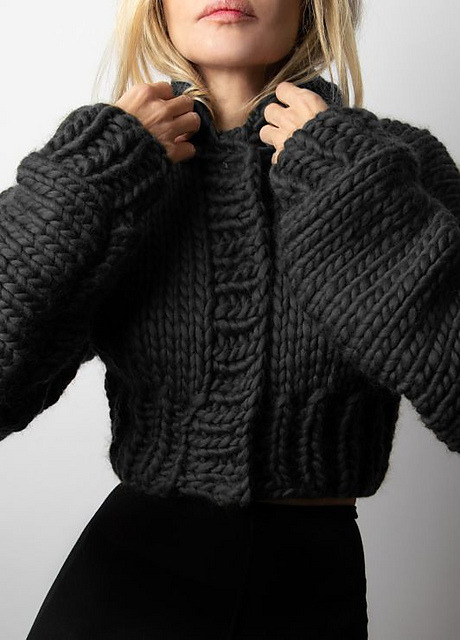
Yes. They are very unique looking. they're striking and sometimes even cool (in a photoshoot at least), but lets take a look at some of the problems with these types of sweaters, and how I feel that they exemplify fast fashion culture, and that culture invading fiber arts spaces as well.
Ethics, Pricing, and plastic waste
Let's take a look at this sweater as a case study for some of the ethical, sustainability, and pricing issues.

I think it exemplifies a lot of the issues with this wave of trendy sweaters.
first, lets take a look at the website. 260 dollars + shipping, 94% plastic, and from a cursory research, there seems to be no evidence that any of that price is going towards a living wage for its factory workers. So, not to be rude, but what exactly am I paying for? I have seen similar pricing and ethical issues almost across the board with these trendy sweaters.
There's nothing wrong with acrylic yarn on an individual level, it is cheap, easy to care for, and easily available, but for 260 dollars on an item that already it dry clean or gentle hand wash only due to its construction? I would expect higher quality materials. also, not this sweater in particular, but in many of these types of sweaters/brands it really bothers me that they have been able to market themselves as 'vegan' as a form of greenwashing when all of their clothes are plastic or mostly plastic. So yes, while its technically true that they are vegan, are vegan clothes really better for the environment when most of the time vegan clothes means more microfiber shedding pollution and eternal piles of plastic clothes waste?
okay, so now lets get to some common issues with the actual wear-ability and construction of these types of sweaters.
Roving Woes
I think everyone remembers these massive, chunky sweaters or even the roving blankets (roving is wool that has been processed but not yet spun). I'm not sure if the tops/sweaters of very chunky yarn are in peak trend anymore but I do see them around.
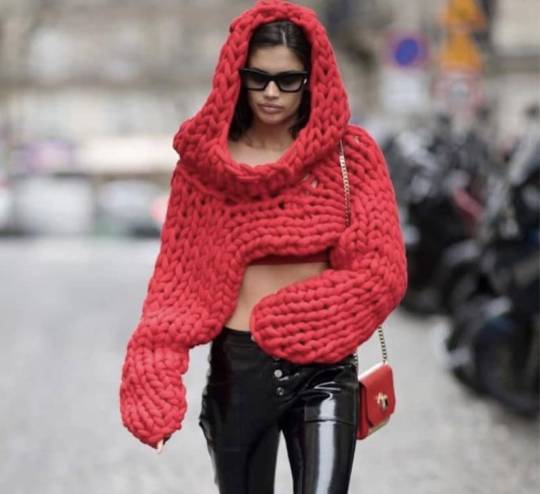
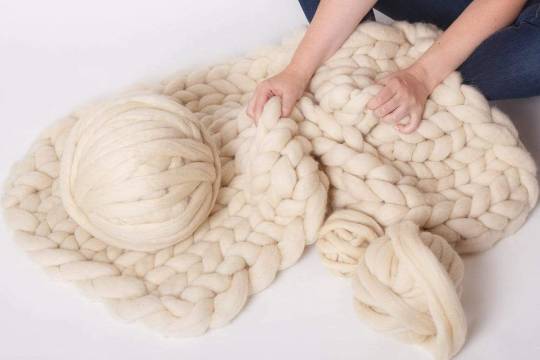
Here's the issue. If you want a garment that will fall apart in one wash, these are for you. If you want to have a garment be a lasting part of your wardrobe, move on.
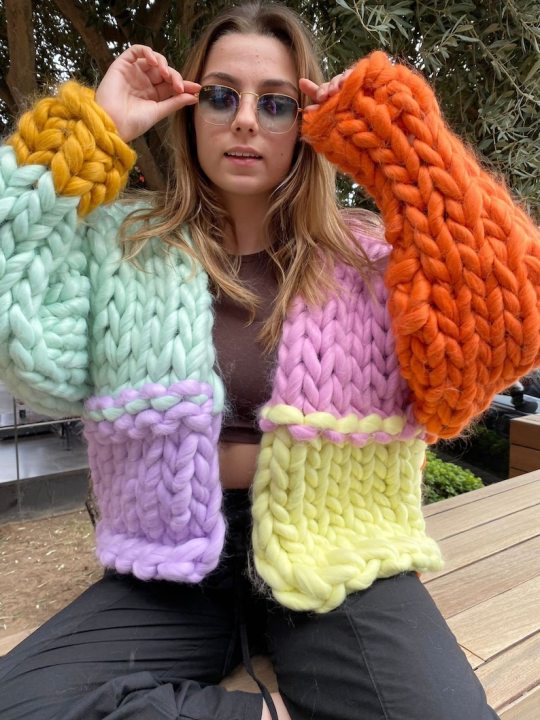
A good example is above. These kinds of sweaters sell like hotcakes on Etsy and go upwards of 300 dollars a pop, but see that fuzziness around the edges? the lack of any twisting look that you'd typically see in yarn? this is roving and will pull, snag, pill, and straight up fall apart at the slightest provocation because the thing that gives spun fibers their strength, is well... the spinning part. The woolery has a great video about this where you can see the roving fall apart over time, and also collect, dirt, dust and other grossness over time with no good way to clean it. Making that 300 dollars you spent a disposable purchase, not an investment. Like buying a 300 dollar disposable rain poncho, but with even less use.
youtube
Finicky detailing
Things like ribbons, charms, and other items make an item hard to wash. If they are not properly secured, or sometimes even if they are, they will come off and either need to be thrown away or somehow reattached. These items can also tug, snag at, or warp the main fabric of the garment.
Neglecting Weaving in Ends
Another trend I've been seeing is not weaving in the ends of a garment, as you can see in that flower sweater above. This may give a cool sort of ripped jeans effect for some, but it will ultimately lead to the garment coming unraveled, and you will have wasted, in this case, like 600 dollars on nothing.
...
Overall, all of these trends lead to more plastic waste, disposable clothing, difficult or impossible to wash items, or clothing that you'll spend a lot of money on only to have it fall apart.
Its frustrating to see this clamoring for dupes or this rush for similar styles take over some fiber arts spaces and lead to wasteful consumption of yarn, and trend cycles where these sweaters quickly get created and then discarded.
thanks for coming to my TED Talk.
151 notes
·
View notes
Text
Measuring Microfibers in Turbulence

Microplastic pollution is on the rise, especially in waterways. Microfibers -- millimeters in length but only microns in diameter -- are especially prevalent, as they get washed out of synthetic clothing. Collecting these pollutants first requires understanding how they move and cluster in turbulent flows. (Image credit: Adobe Stock Photos; research credit: V. Giurgiu et al.; via APS Physics) Read the full article
49 notes
·
View notes
Note
What would be Sephiroth's hair routine?
If Sephiroth had a hair care routine...
• The topic of Sephiroth's hair garners many rumors in the Silver Elite fandom, especially after the information was released that Sephiroth uses an entire bottle of shampoo each wash. Some say he has a complicated, ten-step hair care routine that he goes through every day, others say his hair is naturally perfect and that he barely has to put effort in it.
• Little to they know that Sephiroth does have a hair care routine, and it is multi-step, but not as complicated as they think.
• When he has the time, he likes to oil his hair at LEAST two hours before he washes it, to eradicate the little grease that accumulates in his hair when he's sweating during combat.
• First, he does co-wash, but he doesn't use an entire bottle of shampoo like the rumors say. Because of his genetics, his hair is self-cleaning (in a way) which allows him to use minimal shampoo which he's VERY selective about.
• His shampoo has to be sulfate-free and without any parabens. If his hair will clean itself, he'd rather not put any harsh ingredients in it.
• Sephiroth does use almost an entire bottle of conditioner though. He usually opts for ingredients that give his hair extra slip and shine, since he hates it when his hair gets tangled.
• He also uses hair masks in the shower religiously. Again, not that he particularly needs it, but he is fond of his hair and likes to treat it well. He alters between nutrition masks and hidration masks.
• After the shower, he gently dries his hair with a microfiber towel before applying a serum and some leave-in conditioner. He waits twenty minutes before starting the arduous process that is brushing and detangling his hair.
• His hair dries abnormally quickly on its own (thank you Jenova cells) but he sometimes will blow dry it just to quicken the process and get the specific end look he wants.
• After that he's done! All ready to step out into the grime and polluted air of Midgar that will leave his hair dryer than a cactuar's ass! And work up a sweat during training and missions that is so ungodly that he'll have to repeat the entire process all over again.
#ff7#ffvii#final fantasy 7#sephiroth#ffvii crisis core#final fantasy vii#ff7 crisis core#sephiroth headcanons
89 notes
·
View notes
Text
44 notes
·
View notes
Text
Sign the petition to demand the creation of a new international law requiring fast-fashion garments to come with a statement of the human cost and environmental harm caused by their creation.
We all know fast fashion is bad for the planet - slave labor, environmental waste, air and water pollution, and unsustainable practices are just a few of the ways they impact our planet, our health and our lives. To date, the fast fashion industry is the 2nd largest consumer of water and is single-handedly responsible for 10% of global carbon emissions (that's more than all international flights and maritime shipping across a year combined). Even the simple act of washing these clothes releases 500,000 tons of microfibers into the ocean each year - that's equal to 50,000 plastic bottles. Fast-fashion is the 3rd leading cause of the climate crises we face, yet is rarely addressed.
Knowing these stats is one thing, and understanding them is important. Being aware of them is somewhat informative. But as long as we keep turning a blind eye to the issue, the stats are only going to get worse, and nothing will change for the better. Ignoring the issue or brushing it under the rug won't help anything. So what if we could see the real-world damage done by each of the garments we buy?
In the same way that cigarette packets have shown the harm their products do to our bodies ("SMOKING KILLS", lung cancer visualizations, etc.), what if fast fashion manufacturers & retailers had to show the harm their products do to our planet?
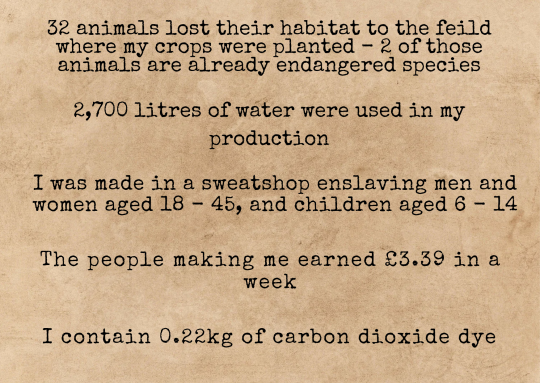
[Image ID: A type-writer font has been used on a brown craft paper background. The text reads: "32 animals lost their habitat to the field where my crops were planted - 2 of those animals are already endangered species. 2,700 litres of water were used in my production. I was made in a sweatshop enslaving men and women aged 16 - 45, and children aged 6 - 14. I contain 0.22kg of carbon dioxide dye." End ID.]
This is a mock-up of a label / statement for a single T-shirt, with researched statistics and educated estimates for the information I couldn't find a calculated answer for.
Now imagine labels / statements like this for every single piece of clothing: how many toxic chemicals are in those new jeans? How many litres of water did that shirt take to make? How many animals were skinned to make those cute fur-trimmed boots? How many children made that jumper? How many people were forcibly removed from their homes, so production companies could plant crops to grow the materials used in clothes manufacturing? How many families were evicted for no reason other than corporate greed? How many trees were cut down? How many animals were displaced or killed?
Would you really want to buy those items of clothing if the answers to those questions were staring you in the face?
If this information was stated in clear, accessible ways on both the website and the ticket on the actual garment, this would dramatically reduce the number of people buying fast fashion items. It would also reduce the profits being made by fast fashion companies, and could lead to many of them being forced to choose between changing and becoming sustainable, eco-froendly and ethical brands, or shutting down due to being boycotted.
Who would really want to knowingly buy things that are made by slaves, or which cost a family their home, or which contributed to deforestation? Who would continue to buy fast fashion items knowing this is the damage caused by them, when sustainable alternatives are an option?
Whether it's second-hand fashion at affordable prices, or investing more money in sustainable products which were made with high ethical standards and which cost more money due to the fact their price accounts for the time it took a person to make that item... we can say for certain that sustainable shopping is going to become much more popular if people know how important that change is. Sustainable items last much longer than fast-fashion items, which by design are created to self-destruct, as they are made to be worn a few times and then discarded in order to be replaced by the next trend's items - and as trends speed up, these items become weaker and weaker. This then leads to people spending more money in order to keep up with the newest trends, and to keep replacing clothes they throw out after a few washes.
In contrast, buying sustainable items which are designed to last years means people won't have to spend money on new clothes every few weeks, which means they'll ultimately save money in the long term and actually be able to afford those pricier items which will last much, much longer.
Now, despite the amount of harm the fast-fashion industry causes to people and the environment, the last thing we should be doing is getting angry at those who continue to buy them. Being the target of anger doesn't make large populations change their behaviour - even a cursory look through history books will tell us that much. Neither does being the target of resentment or blame.
But guilt? Shame? Those are two of the most powerful emotions to magnify when you want change to happen in waves.
And frankly, if people feel ashamed of buying something, or if buying something makes them feel guilty... they're going to stop buying it.
Those aren't the only emotions that should be felt, though. Because only feeling guilt and shame leads to feeling hopeless, scared, anxious and depressed. And we don't want that. No matter how bad things get... we don't want that.
The only other emotions to provoke are hope and pride.
If there's no hope for the future, how can anyone be expected to imagine a better one?
You wouldn't think it, what with all the climate crises and disasters we experience around the world and the total lack of commitment made by billionaires, multimillion-dollar companies and corporations and politicians.
But it's true. Scientists in Scotland have discovered bacteria which eat plastic and speed up the decomposition of it. ‘Ecocide’ is now punishable by law. Some countries within the EU are already close to meeting their 2030 goals years ahead of schedule! Thanks to scientists and small, individual changes made on a massive scale by ordinary people who are making small adjustments to our everyday choices, we can and are healing most of the ozone layer before 2050. That is something we should all feel incredibly proud of.
So imagine how much we could speed that process up if more people made those changes. Imagine how much sooner we could heal our planet if billions of people made those changes, rather than millions. Imagine how much sooner we could be seeing the effects of a healthier planet if fast fashion companies were forced to choose between going green and transparent, or closing altogether due to a lack of interest from consumers. Imagine the changes we could create if corporations made massive changes in a short amount of time, in order to save their own profits.
Imagine more labels like this, sitting alongside each other on every single piece of fast fashion clothing. A statement like this beneath every item of clothing on fast fashion websites, which transparently states the harm done.
If every single fast-fashion company and store had to display this on their clothing, on their racks, on their websites, and if there were legal punishments for those who tried to evade or lie... fashion would turn a lot greener very quickly. We'd start seeing more and more labels with "I'm made from 6 plastic bottles! I used to be a newspaper! I had 0 pesticides used on me in my production! I only contain natural dye made from berries, beans and sustainably grown flowers. I was made from apple skins and corn! The people who made me get to go home to their families every night, have days off and the adults made £150.35 each in 1 week! The animal who made the wool for me is free-range and well-cared for! I came from a small family farm, and was created with a closed-loop water system!”
That'd be a much better civilisation to shop in, don't you agree?
That is hope for the future.
That is motivation, which can fuel ordinary people to do extraordinary things and create changes they thought were impossible.
If you want to be a part of creating this change, sign the Change.org petition which demands the the creation and implementation of an international law which will require all fast-fashion products to be displayed with a statement which states the harm done to people and the planet by that garment being made & shipped.
#fast fashion#fashion#climate crisis#climate change#climate action#climate catastrophe#environmentalism#environment#environmetalists#enviromental#sustainability#sustainable#economy#ecofriendly#ecosystem#europe#earth#ecommerce#society#socialist#sociology#social justice#social media#slave labor#children#child labor#children's rights#environmental justice#petition#petitions
43 notes
·
View notes
Text
Excerpt from this story from EcoWatch:
Microplastics shed from plastic products like clothing and packaging are ending up in the fish we eat, according to researchers from Portland State University (PSU).
The findings of the study highlight a need for strategies and technologies to reduce the microfiber pollution that makes its way into the environment, a press release from PSU said.
“Microplastics (MPs) and other anthropogenic particles (APs) are pervasive environmental contaminants found throughout marine and aquatic environments. We quantified APs in the edible tissue of black rockfish, lingcod, Chinook salmon, Pacific herring, Pacific lamprey, and pink shrimp, comparing AP burdens across trophic levels and between vessel-retrieved and retail-purchased individuals,” the researchers wrote in the study. “Anthropogenic particles were found in 180 of 182 individuals… These findings suggest a need for further research into technologies and strategies to reduce microfiber pollution entering the environment.”
Scientists from the Applied Coastal Ecology Lab at PSU built on earlier research that explored the pervasiveness of microplastics in bivalves such as Pacific razor clams and oysters, the press release said. Led by Elise Granek, an environmental science and management professor, the team focused on commonly eaten crustaceans and finfish.
Their goal was to fill in the gaps regarding microplastic contamination in shellfish and finfish in Oregon, while gaining a better understanding of differences across trophic levels — which arrange the position of fish in the food chain — as well as in pathways to consumers.
The researchers quantified particles from materials modified or produced by humans that they discovered in the edible tissues of half a dozen species that are culturally or economically important in Oregon: Chinook salmon, lingcod, black rockfish, Pacific lamprey, Pacific herring and pink shrimp.
The team then compared concentrations of particles across trophic levels, as well as whether where the microplastics were positioned in the food web had an effect on how much and what was contaminating the edible tissue of the fish. They also looked at whether samples obtained directly from research vessels differed from those of seafood vendors and supermarkets.
The researchers found 1,806 suspected plastic particles in 180 out of 182 individual samples. Fibers were most abundant, followed by films and fragments.
6 notes
·
View notes
Text

06-07-23 Why Patagonia helped Samsung redesign the washing machine
Samsung is releasing a wash cycle and a new filter, which will dramatically shrink microfiber pollution.
Eight years ago, Patagonia started to study a little-known environmental problem: With every load of laundry, thousands (even millions) of microfibers, each less than 5 millimeters long, wash down the drain. Some are filtered out at water treatment plants, but others end up in the ocean, where fibers from synthetic fabric make up a surprisingly large amount of plastic pollution—35%, by one estimate. Fragments of your favorite sweatshirt might now be floating in the Arctic Ocean. In a collaboration that began two years ago, the company helped inspire Samsung to tackle the problem by rethinking its washing machines. Today, Samsung unveiled its solution: A new filter that can be added to existing washers and used along with a “Less Microfiber” cycle that Samsung also designed. The combination makes it possible to shrink microfiber pollution by as much as 98%.
[…] Patagonia’s team connected Samsung with Ocean Wise, a nonprofit that tests fiber shedding among its mission to protect and restore our oceans. Samsung shipped some of its machines to Ocean Wise’s lab in Vancouver, where researchers started to study how various parameters change the results. Cold water and less agitation helped—but both of those things can also make it harder to get clothing clean. “There are maybe two ways of increasing the performance of your washing machine,” says Moohyung Lee, executive vice president and head of R&D at Samsung, through an interpreter. “Number one is to use heated water. That will obviously increase your energy consumption, which is a problem. The second way to increase the performance of your washing machine is to basically create stronger friction between your clothes . . . and this friction and abrasion of the fibers is what results in the output of microplastics.” Samsung had already developed a technology called “EcoBubble” to improve the performance of cold-water cycles to help save energy, and it tweaked the technology to specifically tackle microfiber pollution. “It helps the detergent dissolve more easily in water so that it foams better, which means that you don’t need to heat up your water as much, and you don’t need as much mechanical friction, but you still have a high level of performance,” Lee says. The new “Less Microfiber” cycle, which anyone with a Samsung washer can download as an update for their machine, can reduce microfiber pollution by as much as 54%. To tackle the remainder, the company designed a filter that can be added to existing washers at the drain pipe, with pores tiny enough to capture fibers. They had to balance two conflicting needs: They wanted to make it as simple as possible to use, so consumers didn’t have to continually empty the filter, but it was also critical that the filter wouldn’t get clogged, potentially making water back up and the machine stop working. The final design compresses the microfibers, so it only has to be emptied once a month, and sends an alert via an app when it needs to be changed. Eventually, in theory, the fibers that are collected could potentially be recycled into new material rather than put in the trash. (Fittingly, the filter itself is also made from recycled plastic.) When OceanWise tested the cycle and filter together, they confirmed that it nearly eliminated microfiber pollution. Now, Samsung’s challenge is to get consumers to use it. The filter, which is designed to be easily installed on existing machines, is launching now in Korea and will launch in the U.S. and Europe later this year. The cost will vary by market, but will be around $150 in the U.S. The cycle, which began to roll out last year, can be automatically installed on WiFi-connected machines.
#microplastics#textiles#laundry#environmental#science#patagonia#samsung#i'm. so excited.#also i HAD been silently judging patagonia a little for their heavy use of synthetics but. they ARE walking the walk actually.#(will say that ime the feel of natural fibers is just. better.)#(like. wool has an astonishing ability to keep you warm-but-not-sweaty at a bizarrely wide range of temps)#(whereas like. the synthetic fleece tops i still have are like. immediately cozy‚ sure‚ but you WILL get sweaty if you get warm)#(like being in‚ you know‚ a plastic bag!)#(so like. even if they Fix the Microplastics Problem i have no regrets abt switching my allegiance to woolens)#(but. still fucking THRILLED they might fix the microplastics problem.)#does make you feel like. i'm unavoidably a humanities person but. what are humanities ppl doing that matters this much.#like fundamentally if you really want to do good in the world you probably SHOULD become a scientist of some kind.#that said‚ science would almost certainly not be improved by my participating in it‚ so like. what can you do.#really hugely awed by & appreciative of scientists tho.#anyway. obvs this is really just a press release and we gotta see how this plays out but.#!
59 notes
·
View notes
Text
Not even the Arctic Ocean is immune to the incessant growth of microplastic pollution. In a new study that analyzed sediment core samples, researchers quantified how many of the particles have been deposited since the early 1930s. As scientists have shown elsewhere, the team found that microplastic contamination in the Arctic has been growing exponentially and in lockstep with the growth of plastic production—which is now up to a trillion pounds a year, with the global amount of plastic waste projected to triple by 2060.
These researchers analyzed the seawater and sediment in the western part of the Arctic Ocean, which makes up 13 percent of its total area. But in just that region, they calculated that 210,000 metric tons of microplastic, or 463 million pounds, have accumulated in the water, sea ice, and sediment layers that have built up since the 1930s. In their study, published last week in the journal Science Advances, they cataloged 19 synthetic polymer types in three forms: fragments, fibers, and sheets. That reflects a dizzying array of microplastic sources, including fragments from broken bottles and bags and microfibers from synthetic clothing.
Overall, the team found that microplastic levels have been doubling in Arctic Ocean sediments every 23 years. That mirrors a previous study of ocean sediments off the coast of Southern California, which found concentrations to be doubling every 15 years. Other researchers have found an exponential rise in contamination in urban lake sediments.
The problem is likely to keep getting worse, lead author Seung-Kyu Kim, a marine scientist at Incheon National University, told WIRED by email. “The input of microplastics into the Arctic has increased exponentially over the past decades, with an annual increase rate of 3 percent,” Kim writes. “The mass production of plastic at an 8.4 percent annual increase—coupled with inefficient waste management systems—is projected to further increase loads of plastic entering the ocean for the next several decades, and thus plastic entering the Arctic will increase proportionally.”
The atmosphere, too, is increasingly infested with microplastics. By one calculation, the equivalent of hundreds of millions of disintegrated plastic bottles could be falling on the United States alone. A study of a peatland area in the Pyrenees found that in the 1960s, less than five atmospheric microplastics were being deposited per square meter of land each day. It’s now more like 180.
This new Arctic paper “helps to show that any increase in production is matched in the environment,” says Steve Allen, a microplastics researcher at the Ocean Frontiers Institute who did the peatland study. “And as more research into human exposure comes to light, I believe the increase will also be shown in human bodies.”
Microplastics are readily moving between different environments. A previous study found 14,000 microplastics per liter of Arctic snow, the stuff having blown in from European cities. Microplastics are also arriving in the Arctic by sea: When you wash your clothes, hundreds of thousands—or even millions—of synthetic fibers break off and flush into a wastewater treatment facility, then eventually to the ocean. Currents then transport microplastics up into the Arctic, where they swirl around and eventually settle in the sediment. Allen and other scientists reported in May that a single recycling facility might emit 3 million pounds of microplastics a year—and those were numbers for a brand-new plant that filtered its runoff water.
Interestingly, this new study found higher levels of microplastics around the retreat line of summer sea ice. This may be due to a biological highway of sorts. The algae Melosira arctica grows on the underside of Arctic sea ice, providing food for organisms like zooplankton. When that ice melts, the algae sinks to the seafloor, taking all those synthetic particles with it. “These clumps sink much more rapidly to the seafloor than other particles, within a day,” says marine biologist Melanie Bergmann of the Alfred Wegener Institute in Germany, who recently reported finding 31,000 microplastics per cubic meter of this algae in the Arctic Ocean. “This could also explain why this [sediment] study, similar to our results from earlier studies, found the highest microplastic burden in the area with high melting rates.”
Bergmann has also found that Arctic sea ice itself is loaded with 4.5 million microplastics per cubic meter. When it melts, the particles are liberated to swirl around in the water column, perhaps sinking to the seafloor. Once the sea ice freezes again, it “scavenges” microplastics from the water by collecting them into the new ice.
The cycling of microplastics through the Arctic Ocean may ultimately affect the food chain: The zooplankton that feed on Melosira arctica algae are eating the particles, and when the microplastics sink to the seafloor, bottom-dwelling creatures eat them too. Filling up on plastics, instead of actual nutrition, is a problem scientists call “food dilution.” “This could affect especially invertebrates like sea cucumbers, brittlestars, and worms that plough through and ingest these contaminated sediments all the time,” says Bergmann.
This burden on ecosystems is why environmentalists and scientists are calling for the United Nations plastics treaty, which is currently in negotiations, to include a dramatic cap on production. In March, researchers provided hints that a cap could produce quick results: They found that although ocean microplastic levels have skyrocketed over the past 20 years, they actually fluctuated between 1990 and 2005—perhaps due to the effectiveness of a 1988 international agreement that limited plastic pollution from ships.
Kim writes that the new paper is another data point in favor of production limits: “This strongly supports the urgent need of globally concerted vigorous action to substantially reduce the plastic ocean input, and thus to protect the Arctic environment.”
32 notes
·
View notes
Text
Eco-Friendly Office Cleaning Services in Dandenong, Victoria

As environmental awareness grows, businesses in Dandenong, Victoria, increasingly seek ways to reduce their ecological footprint. One impactful approach is adopting eco-friendly office cleaning services. These sustainable cleaning solutions ensure a clean and healthy workplace and demonstrate a commitment to protecting the environment.
In this article, we'll explore the benefits of eco-friendly office cleaning, the practices employed by green cleaning companies, and how Dandenong businesses can switch to sustainable cleaning solutions.
Why Choose Eco-Friendly Cleaning?
Switching to eco-friendly office cleaning offers numerous advantages for businesses, employees, and the environment. Here are some key reasons to make the change:
1. Healthier Work Environment
Traditional cleaning products often contain harsh chemicals that can negatively impact indoor air quality and irritate employees. Eco-friendly cleaning solutions use non-toxic, biodegradable products that are safer for both people and the planet.
2. Environmental Responsibility
By choosing sustainable cleaning practices, businesses help reduce water pollution, landfill waste, and carbon emissions. It's a meaningful way to support global environmental goals while making a local impact in Dandenong.
3. Positive Brand Image
Demonstrating a commitment to sustainability enhances your company's reputation. Clients, partners, and employees are more likely to respect and support businesses prioritising eco-friendly practices.
4. Cost Efficiency Over Time
Eco-friendly products are often concentrated and long-lasting, reducing the frequency of reordering supplies. Additionally, energy-efficient equipment lowers utility bills, offering long-term cost savings.
Eco-Friendly Cleaning Practices
Green cleaning companies in Dandenong employ a variety of eco-friendly practices to ensure effective and sustainable cleaning. These methods prioritise both the cleanliness of your office and the planet's health.
1. Non-Toxic Cleaning Products
Eco-friendly cleaning products are free from harsh chemicals like ammonia, chlorine, and artificial fragrances. They are biodegradable, safe for humans and pets, and leave no harmful residues.
2. Energy-Efficient Equipment
Green cleaning companies use energy-efficient tools, such as vacuums with HEPA filters, which improve air quality while consuming less power. Steam cleaners are also popular for sanitising surfaces without chemical solutions.
3. Water Conservation
Eco-friendly cleaning services employ water-saving techniques, such as using microfiber mops and cloths that require less water than traditional cleaning methods.
4. Waste Reduction and Recycling
Green cleaning companies promote recycling by properly separating waste and disposing it responsibly. To reduce landfill waste, they may also use reusable cleaning tools, like washable cloths and mop heads.
5. Green Certifications
Reputable eco-friendly cleaning providers often adhere to recognised environmental standards, such as Green Seal or ISO 14001. These certifications ensure that their practices meet strict sustainability criteria.
Benefits for Businesses in Dandenong
Eco-friendly office cleaning is particularly beneficial for businesses in Dandenong, a region that strongly emphasises community well-being and sustainability.
1. Compliance with Local Regulations
Many industries in Dandenong, including manufacturing and healthcare, have strict environmental and health regulations. Green cleaning practices help businesses meet these requirements.
2. Support for Local Sustainability Initiatives
By choosing eco-friendly cleaning services, businesses contribute to local efforts to reduce waste, conserve resources, and promote cleaner air and water.
3. Employee Satisfaction
A healthier work environment leads to happier employees. When staff members feel that their workplace is safe and aligned with their values, it fosters loyalty and improves morale.
4. Attracting Eco-Conscious Clients
Businesses prioritising sustainability appeal to a growing base of environmentally conscious clients and partners, giving them a competitive edge in the market.
What to Look for in an Eco-Friendly Cleaning Provider
When searching for green office cleaning services in Dandenong, choosing a provider that aligns with your sustainability goals is important. Here are some factors to consider:
1. Green Products and Equipment
Ensure the provider uses certified eco-friendly cleaning products and energy-efficient equipment.
2. Customisable Cleaning Plans
A good cleaning company should offer flexible plans tailored to your office's needs, such as high-traffic areas or sensitive equipment.
3. Experience and Reputation
Look for a provider with experience in eco-friendly cleaning and positive reviews from local businesses in Dandenong.
4. Transparency
Reputable green cleaning companies are upfront about their practices and can provide details about their environmental policies and certifications.
Leading Eco-Friendly Cleaning Services in Dandenong
Several cleaning companies in Dandenong specialise in eco-friendly solutions, offering reliable and sustainable services for businesses of all sizes. Here are a few options:
1. EcoClean Melbourne
Known for its commitment to green cleaning, EcoClean Melbourne uses non-toxic products and energy-efficient equipment to deliver high-quality results.
2. GreenSpark Cleaning
This company offers tailored cleaning services that prioritise environmental responsibility. Their use of biodegradable products and waste-reduction techniques makes them a popular choice.
3. EnviroClean Solutions
EnviroClean provides a full range of eco-friendly office cleaning services, from basic maintenance to deep cleaning. They specialise in serving industries with strict hygiene standards, such as healthcare and hospitality.
How to Transition to Eco-Friendly Cleaning
Switching to green cleaning services is a straightforward process that can significantly benefit your business.
Steps to Get Started:
Assess Your Needs
Identify the specific cleaning requirements of your office, including frequency and key areas that need attention.
Research Providers
Look for cleaning companies in Dandenong that specialise in eco-friendly practices and have a track record of success.
Request a Quote
Compare pricing and services to find a provider that fits your budget and sustainability goals.
Communicate Expectations
Clearly outline your expectations, including using green products, energy-efficient practices, and waste management.
Monitor Performance
Regularly evaluate the quality of cleaning services and their alignment with your sustainability goals.
Final Thoughts
Eco-friendly office cleaning services in Dandenong, Victoria, are an excellent way for businesses to maintain a clean and healthy workspace while supporting environmental sustainability. Choosing a green cleaning provider can reduce your ecological footprint, improve employee well-being, and enhance your brand's reputation.
Making the switch to sustainable cleaning practices is a step toward a cleaner future��not just for your office but for the community and the planet as a whole. Take the first step today by exploring the eco-friendly cleaning options available in Dandenong.
2 notes
·
View notes
Text
two long essay posts sitting in my likes rn. one is about ai art ethics and the other is about the fast-fashion-ization of crafting and i think they're kind of the same thing
i've recently gotten into crochet. i don't have a ton of money to spare on artisanal hand-dyed natural fiber yarns, so i've been using the cheap acrylic stuff. without doing any research i can fairly safely assume that everything i am using, in addition to shedding plastic microfibers into our waterstreams and bloodstreams, was made by exploited people in a hazardous factory setting because that is the state of most global manufacturing today. if i continue to buy that yarn, am i directly responsible for the ocean pollution and worker exploitation involved in its production? non-rhetorical question, i don't think there's a simple yes or no answer.
same thing with ai. personally i don't think there's any kind of inherent evil to using publicly hosted artwork as training data (so many of my favorite art practices – from collage to readymades to drag lipsync tracks to music sampling to being 14 and tracing my favorite manga panels – rely on "stealing" the work of other artists without permission). but even if ai image generators were fundamentally exploitative in their sourcing, would their usage by random everyday people be any more inherently evil than me using unethically sourced yarn for my crochet projects?
idk. i do personally feel put off by most ai art i see (including the dunes video that sparked a lot of this buzz among my mutuals) because i find it aesthetically uninteresting and i can't stand the nft tech bro types who seem to gravitate towards it, but i am working on separating my moral judgements and my aesthetic judgements, which is much easier said than done. yesterday i saw someone say "ai is gross and scary" which like yeah it is! but that doesn't make it inherently evil, it is simply a tool
i don't believe in corporate sanctioned copyright laws or the almighty power of intellectual property and originality, nor do i ascribe much importance to ill-defined concepts like "human creativity" (inb4 hello i am a professional ~traditional~ artist and art teacher). but also i don't like to lean too hard on "no ethical consumption under late capitalism" as an easy way out to just do whatever regardless of the consequences. whatever to do!
#me when i'm experiencing nuance on the piss on the poor website#made a post about this yesterday while actively annoyed and it came off way too hostile and rude so i'm trying again lol#.txt#other people have said smarter more coherent things about ai's role in destabilizing the livelihoods of illustrators & writers#hence why it's left out here
18 notes
·
View notes
Text
Wearing synthetic clothing sustainably
I have seen a lot of discussion on the Internet about the environmental impact of natural fibers and synthetic fibers used to make clothing. Synthetic fabrics are made from oil, just like plastic is. According to the attached article, “Petrochemical-based synthetics make up 65% of all fibers produced annually, with polyester by far the most widely used synthetic fabric. Despite the serious environmental impacts of cotton production, a T-shirt made from cotton produces 2.1 kg CO2-eqemissions while a polyester T-shirt emits an estimated 5.5 kg CO2-eq.” Synthetic fabrics also contribute to plastic pollution. Washing clothes breaks off microfibers that contribute to microplastic contamination in waterways. Coatings on fibers or clothing contribute to pollution when they wash off and some are made with chemicals that are harmful to us and the planet.
However, sometimes you need the qualities produced by synthetic fabrics and the treatments/coatings applied to the fabric, such as waterproofing. Here are some ideas on how to reduce the environmental impact of clothing made with synthetic fibers.
Buy clothing made from recycled materials when possible. Several manufacturers have begun making clothing using some recycled materials, so look for them.
When evaluating clothing ,whether new or made from recycled materials, look for textile certifications such as Bluesign and Oeko-Tex, which indicate that a product was made with only safer materials and treatments.
You can reduce microfiber pollution by using cooler, faster laundry cycles. Hanging clothes to dry reduces microfiber pollution and also saves energy.
Research microfiber filters that can be installed on your washing machine to capture the microfibers.
Purchase fewer clothing items of higher quality and maintain them carefully. Read the laundering instructions on the label inside the item of clothing. Some clothing requires special detergents or laundry cycles to maintain their waterproof or fire-retardant properties. Clothing that is properly maintained will last much longer, hopefully leading to fewer resources being used to make new clothing.
14 notes
·
View notes
Text
The Fast Fashion Industry and Its Environmental Costs
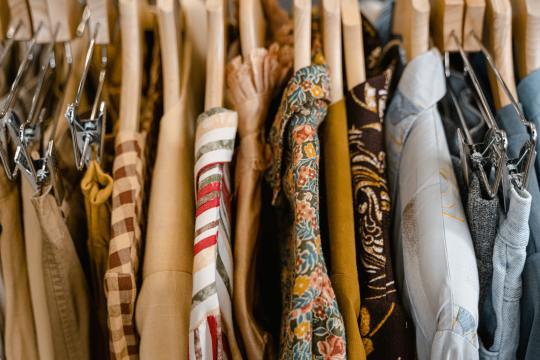
With the ever-changing fashion trends circulating on social media and the affordable prices in stores, the fast fashion industry has continued to grow over the past decade with quick online deliveries, rapid clothing production, and overconsumption of clothing items. Many companies within the fashion industry have opted to have their manufacturers overseas for cheap labor to avoid the high minimum wages enforced by developed nations. Although more affordable garments are now accessible to low-income people, it also comes with the cost of ecological destruction and humane indecency.
Forced Labor for profits
Many companies such as Shein, Forever 21, H&M, Urban Outfitters, and Zara use sweatshops, workplaces with socially unacceptable conditions that pay low wages to produce low-cost clothing items. Although these companies can maintain a low price tag on their products, they become part of the unsustainable practices of fast fashion because of underpaid labor, poor working conditions, and a longing contribution to plastic production. By consistently shopping from these brands, many support the unsustainable practices that are the backbone of these companies. Instead, choosing to shop at thrift stores, only buying clothes when necessary, reusing old clothing items, thinking before purchasing, and creating a capsule wardrobe, a set of clothes that can be worn interchangeably, can reduce the need to support the production of these companies.
Materials used
When companies want to profit while manufacturing clothing, they tend to choose low-cost artificial synthetic fibers such as polyester, rubber, and nylon, which take more energy to produce than natural fibers such as wool, cotton, and bamboo. Natural fibers have a lower environmental impact throughout manufacturing because they do not require as many chemicals as synthetic fibers. When choosing what clothing garments to buy, purchasing the ones manufactured with natural fibers is more beneficial to our environment because they can break down quickly in nature.
Polluted waters and excessive water use
The fashion industry is one of the most water-intensive industries because it uses water to spin, dye, and finish the textile. Its use of dye has contributed to the wastewater dumped into our streams, rivers, and oceans, which can spread toxic chemicals to marine ecosystems.
Plastic microfibers
Not only is the pollution of waters happening before the sale of items, but after customers buy clothes, the presence of microfibers that detach when it is in the washer goes into wastewater that will eventually reach our oceans, further polluting them. With filtration as the only laborious and expensive way to remove microplastics, it becomes unsustainable and remains in the ocean. It ends up in the human food chain through agricultural communities and sea life, ultimately causing adverse health effects.
Textile waste
As fashion trends constantly change with the modern age of technology and fast fashion's affordability, many garments are discarded and donated not long after purchase. Although donating might seem like a better, more sustainable way to recycle clothing, it might end up in landfills regardless if not sold. According to the Ellen Macarthur Foundation, "it is estimated that people are buying 60 percent more clothes and wearing them for half as long." This practice has only increased over time, allowing truckloads of textiles to be dumped into landfills or incinerated every second. To better maintain our clothes, one should be more conscious about purchases by deciding if a clothing piece has the potential to be worn multiple years after its purchase, lessening the need to throw away or donate so often.
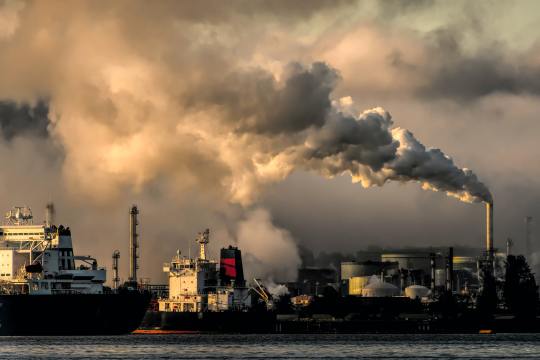
Carbon emissions
With the production and incineration of clothing items, carbon emissions are released into the air, causing public health dangers to communities around factories. The World Bank says, "The fashion industry is responsible for 10 % of annual global carbon emissions, more than all international flights and maritime shipping combined." With new technologies that try to capture the pollutants, "they remain present and often are turned into a dangerous substance," which will pollute our air regardless.
Solutions
With the overwhelming amount of affordable clothing items that are ecologically damaging, being more conscious is always a way to reduce the effects of consumerism. It is ultimately up to us, consumers, to beware of the adverse impacts of supporting unsustainable brands and find eco-friendly companies that put the planet first. Some sustainable brands to shop from are:
Patagonia
Raven + Lily
The Classic T-Shirt Company
Cou Cou Intimates
My Mum Made It
Avani
Good Guys
Shopsoftlana
L'Envers
Pela
Sources
#climate change#earth#environment#environmentalism#epa#climate justice#fast fashion#carbon emissions#carbon footprint#microplastics
9 notes
·
View notes